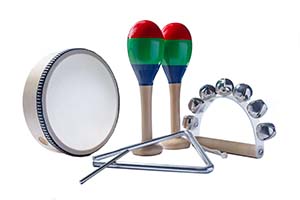Prpe. Lesson 10. Higher and lower sounds II
Prior learning: None
Duration: 30 minutes
Materials: None
Keywords: Beat, singing, chanting, partners, rhymes, circle games
Difficulty: ![]()
 Melodic development
Melodic development
![]() Students identify high and low sounds in the melody and use their hands to describe the melodic contour.
Students identify high and low sounds in the melody and use their hands to describe the melodic contour.
- Sing the song to the class line-by-line in a gentle voice.
- Raise your arm high when the melody is high, low when the melody is low, and in the middle when you sing, "Now I'm in the middle, and I don't know where to go."
- Students should be seated on the floor and imitate your actions with their hands to match your singing.
- When students are familiar with the song, they should sing and use hand movements to follow the melodic contour.
- Individual students are selected to come to the front and follow your hand movements.
- Repeat as often as time permits.
 Game
Game
![]() Students copy the teacher and sing to demonstrate keeping the beat with this popular circle game.
Students copy the teacher and sing to demonstrate keeping the beat with this popular circle game.
- Sing the lyrics to Old Brass Wagon.
- Students should hold hands and are guided by the teacher to move in a circle while holding hands.
- It will be helpful to guide the children by saying, “Turn to the left - do we remember which way is left?
- Sing "Ready, steady, off we go!' and then begin the song with the class singing along with you.
- Students should then be facing to their left.
- Tell the class to stamp their feet to the beat as they sing the song ["Circle to the left..."] and move in a circle.
- Repeat, then stop and instruct the class that they will now circle to their right.
- Sing "Ready, steady, off we go!' and ask the children to circle to their right and sing the second verse ["Circle to the right...]
- In the last verse, children should move in and out towards the circle's centre ['Everybody in...]
 Rhythmic development
Rhythmic development
![]() Students practise a rhyme with clear diction and expressive speaking.
Students practise a rhyme with clear diction and expressive speaking.
Lyrics
Pussycat, pussycat, where have you been?
I’ve been to London to visit the queen.
Pussycat, pussycat, what did you there?
I frightened a little mouse under her chair!
- When students are secure with the rhyme, the teacher should ask questions, such as "Who went to London?" The students should offer answers.
- A student from one half of the class should ask a question, such as "What did the Pussycat do?" while students from the other half should answer.
- One student asks a question, and the class can answer.
- One student asks a question, and one student answers.
- Ensure students concentrate on expressive speaking and clear diction.

The origins of this rhyme go back to the history of 16th-century Tudor England. One of the staff of Queen Elizabeth had an old cat that roamed throughout one of her castles. On one occasion, the cat went underneath the throne, and the cat's tail brushed against the Queen's foot, startling her. But the queen had a sense of humour and declared that the cat might wander through the throne room because it kept the mice away!
 Listening
Listening
![]() Students listen to a selection of sounds and determine whether they are high or low.
Students listen to a selection of sounds and determine whether they are high or low.
- Each audio file comprises high sounds and low sounds.
- Play each track and explain that each instrument will play both high and low sounds – which comes first and which comes second?
- Students should touch their heads for a high sound and their shoulders for a low sound.
 Visual learning
Visual learning
![]() Students explore and identify the concept of high and low through visual activities.
Students explore and identify the concept of high and low through visual activities.
 Video
Video
![]() Students recognise and explore the concept of high and low in this animation featuring Zak and Zoe.
Students recognise and explore the concept of high and low in this animation featuring Zak and Zoe.
 Farewell
Farewell
![]() Reinforces students' pitch ability through listening, imitation, and repetition. 'Good morning' or 'Bee, Bee, Bumblebee' are good examples.
Reinforces students' pitch ability through listening, imitation, and repetition. 'Good morning' or 'Bee, Bee, Bumblebee' are good examples.
Suggested lessons
Prep. Lesson 11. Different sounds
Students discover sounds that are made from wooden and metal instruments. AC9AMUD01
Prep. Lesson 12. Louder and softer sounds II
Students learn that sounds can be louder or softer. AC9AMUD01
Prep. Lesson 13. Longer and shorter sounds
 Students learn that sounds can be longer or shorter. AC9AMUD0
Students learn that sounds can be longer or shorter. AC9AMUD0


